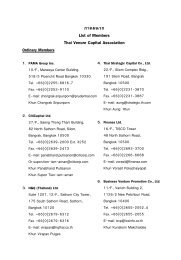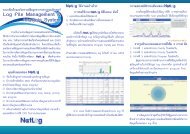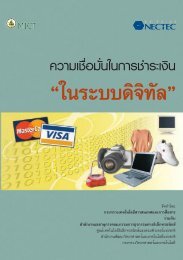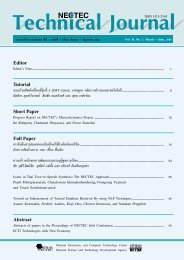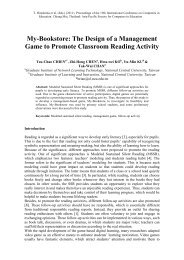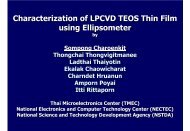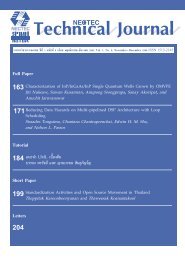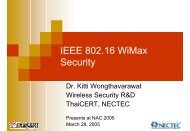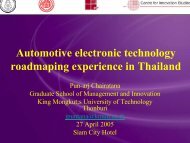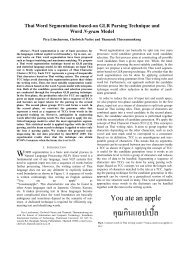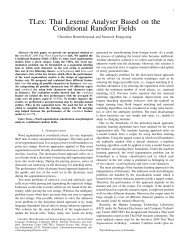ICCE 2009 Publications Format - Nectec
ICCE 2009 Publications Format - Nectec
ICCE 2009 Publications Format - Nectec
Create successful ePaper yourself
Turn your PDF publications into a flip-book with our unique Google optimized e-Paper software.
T. Hirashima et al. (Eds.) (2011). Proceedings of the 19th International Conference on Computers inEducation. Chiang Mai, Thailand: Asia-Pacific Society for Computers in Educationunrelated chapter and check a large number of unrelated data, Erol Ozcelik indicated that toenhance learning, unnecessary searches for irrelevant information should be minimized[13].Using contextual cues to revisit objects is a useful skill. Dr. Marvin Chun definescontextual cueing as the manner in which the human brain gathers information from visualelements and their surroundings [6]. When memorizing a visual object, people can naturallyassociate the context of the object to the object. When searching for an object, they canlocate the object by recalling the related contextual cues. Contextual cues can be the objectsaround target objects, the spatial layout of target objects, or the trajectories of the targetobjects. Books provide certain contextual cues for readers to recall from memory and searchfor information [12]. Readers can perceive the thickness of a book by using their senses ofsight and touch, and can realize the approximate location of information regarding the textas a whole [7]. Another example of employing contextual cues is the use of bookmarks toseparate a book into different sections, facilitating the search for information. In contrast,the digital properties of an e-book erase all traces of tangibility, which consequently erasesthe spatial and temporal performance of a tactile object (such as paper) [11]. Therefore,certain contextual cues that are used when reading physical books disappear. In our previousstudy, chapter names and the visualization of each page are significant when readers revisitinformation because they can perceive location with ease and find information quickly [17].However, contextual cues supported in e-books are used depending on the readinghabits of individual readers; if they are passive during reading, contextual cues are used lesscompared to readers who have a few contextual cues to help them review content and findinformation quickly in the review stage. All reading strategies are for the purpose ofrendering reading more active, and the SQ3R reading strategy is common and easy[18].When readers utilize SQ3R to read their textbooks, they are required to write down all thechapter names hierarchically on paper, and use 5W1H (why, what, when, who, where, andhow) to transform chapter names to questions, and focus on finding the answer to thequestions when they read the content. Writing down all the chapters and questions on a sheetof paper can provide readers with an overview of content, though a connection betweenquestions and content is lacking. However, if readers write the questions next to the chaptersin textbooks, they lose the overview of the content. When they want to find a question andrelated content, they must check the table of contents or flip through the pages. Therefore,this study designed an e-book system with integrated contextual cues and the SQ3R readingstrategy, in addition to an overview and connection property.2. Related work2.1 Scrollbar with cuesScrollbars are a common type of widget for readers to navigate digital documents, thoughthey can only indicate a rough approximate position in a document, and have weak efficacyfor helping users form a mental model of the material during their reading [10]. Numerousstudies have improved the interaction and exhibition of scrollbars. Donald Byrd inputted theresults of different keyword searches into the scrollbar by using colored marks [3]. Laaksoet al. designed a bookmark scrollbar that has a bookmark area next to the scrollbar [10].Footprint scrollbars use colored marks overlaid with numbers and situated in the scrollbar toprovide spatial cues to previously visited areas [1]. Content-Aware scrolling changes thescrolling direction based on the order of content. Context-aware scrollbars are useful whenreading multi-column documents [8].
T. Hirashima et al. (Eds.) (2011). Proceedings of the 19th International Conference on Computers inEducation. Chiang Mai, Thailand: Asia-Pacific Society for Computers in Education2.2 SQ3R reading strategyReading ability is important for students, because it not only influences their scores ofcourses, but also influences their achievements in society [5]. Taraban et al. found thatcollege students with higher scores use more reading strategy during their learning [16]. TheSQ3R method is a common reading strategy and widely used for reading [18]. SQ3R wasintroduced by Francis Pleasant Robinson in his 1946 book Effective Study [15], and SQ3Rstands for Survey, Question, Read, Recite, and Review.In Survey stage, learners only have to skim over the title, headings, graphs, charts,introductory and summary. In Question stage, learners can ask many questions by using5W1H(what, why, where, when, who, and how)to transfer the headings or title intoquestion, for instance: heading name “Virtual machine”, and learners can ask “What isvirtual machine?”. In Read stage, learners need to read one section at a time in order to seekthe answers to questions asked by themselves. In Recite stage, learners should recite thecontent after reading, and answer the questions by using their own words. In Review stage,learners can test themselves by questions which they ask in order to know whether themunderstand or remember the content or not.Reading strategy can enhance learner comprehension of content, though for learnersto become familiar with the reading strategy in a short period is difficult, due to less trainingor time consumption [2]. Guozhen Zhang et al. designed a distance-learning support systembased on the SQ3R reading strategy, and they support a large number of useful tools to assiststudents to execute SQ3R, including a material map, query tool, memo tool, maker tool,glossary tool, search tool, quiz tool, and progress-confirming tool [18]; however, they arenot useful for guiding students to execute SQ3R, and the reading strategy has been lesscommonly used in applications of e-book design in recent studies.3. System descriptionAccording to previous studies, the concept of the proposed design is as follows:1. Reconstruct contextual cues (space) of a textbook to enable students to navigateintuitively and operate similarly to physical books.2. Integrate the SQ3R method and contextual cues into e-books.In physical books, individual pages are perceived by using the senses of sight and touch,though in e-books readers perceive objects by using their sense of sight. Therefore, thevisualization of each page is necessary, and readers can navigate any page.3.1 HardwareThis study used a touch-screen notebook (screen size: 1366x768) as the hardware for thesimulation of the e-books, and the reader can hold it in both hands to read the content (Fig 1and Fig 2).
T. Hirashima et al. (Eds.) (2011). Proceedings of the 19th International Conference on Computers inEducation. Chiang Mai, Thailand: Asia-Pacific Society for Computers in EducationFig. 4 System InterfaceIn Figure 4, the flag icons represent the beginning of each subchapter. Each dotrepresents a page in the chapter. The dark dots represent a page that has been read for a longtime period in the chapter. The reader can add a bookmark or note icons below each dot toremind readers of contextual cues. These contextual cues can be landmarks related to asingle page in space.4. Methods4.1 Participants26 undergraduates from the department of computer science in NCU were recruited, andpretests were conducted to distribute students fairly into the experimental group and controlgroup (13 participants in both groups). Participants of the experimental group wererequested to use the proposed e-book system to study material for their operating systemcourse that they were enrolled in that semester. The approach to operating each step ofSQ3R in the proposed e-books was shown. Participants of the control group were asked touse Acrobat Reader to read the same material (because functions of Acrobat Reader aresimilar to functions of most e-book reading software) and they were not permitted to usefull-text search because we wanted to observe their navigation behavior.4.2 ProcedureTask 1: Subjects are requested to use their assigned e-books to read material in 75 m beforetaking a test. A week after finishing Task 1, they are asked to complete Task 2 and Task 3.Task 2: Several paragraphs were extracted from the material before subjects were asked tofind the page of the assigned paragraph and write down the page number.Task 3: Subjects were asked to use their assigned e-books to review the content in 10 mbefore taking a test.Subjects were observed via webcam to record the duration and reading behavior, and forfinding the assigned paragraph and recording post-task interviews and questionnaire (usingthe five-point Likert scale).5. Results
T. Hirashima et al. (Eds.) (2011). Proceedings of the 19th International Conference on Computers inEducation. Chiang Mai, Thailand: Asia-Pacific Society for Computers in EducationFor Task 1, the average score of the experimental group was 75.9, and this was higher thanthe average score of the control group (69.3). For Task 2, the average time for findinginformation in the experimental group was 8 minutes and 45 seconds, which was muchfaster than the average time of the control group (14 minutes and 20 seconds). For Task 3,the average reviewing score of the experimental group was 74.5, and this was higher thanthe average reviewing score in the control group (62.7).5.1 The SQ3R methodQuestionnaire:PointIt is easy for you to conduct the SQ3R method when using this e-book 4.15system.In the Survey Stage, adding flags can help you have general ideas of the 4.69location of each subchapter in a chapter.In the Question Stage, presenting a question form automatically can4.23help you ask questions.In the Read Stage, perceiving the functions of highlighting, taking notes 4.23and adding bookmarks are sufficient for reading.In the Recite Stage, it is easy for you to retrieve the questions. 4.31In the Review Stage, collecting questions into a document can help you 4.38review content.You would like to apply the SQ3R method to guide your learning. 4.23You could form the habit of conducting the SQ3R method. 4.38Subjects stated that they did not know the SQ3R method beforehand. They couldstill conduct SQ3R easily by following the system’s guide. Furthermore, most subjects likedbeing guided to conduct the SQ3R method during their own learning because they thoughttheir learning would be efficient if they spent a little more time. In addition, they suggestedthat in the review stage, the system’s automatic collection of all the questions was good,though if the system can provide author or peer questions, this would be an improvementbecause they can have the opportunity to learn material with different perspectives.5.2 About contextual cuesQuestionnaire:PointContextual cues in this system can help you revisit information quickly. 4.62Contextual cues in this system can help you review content. 4.54Contextual cues in this system can help you grasp the structure of the4content.You would like to use this e-book system for reviewing content. 4.46You would like to take this e-book system to attend classes. 4.15You would like to use this e-book system for learning. 4.23Subjects thought that contextual cues in the proposed e-book could help them grasp thestructure of the content and facilitate revisiting information. They could know the locationof each subchapter in a chapter and the number of pages of each subchapter via visualizationof each page and flag. Therefore, they can plan the time reading any given subchapter. Due
T. Hirashima et al. (Eds.) (2011). Proceedings of the 19th International Conference on Computers inEducation. Chiang Mai, Thailand: Asia-Pacific Society for Computers in Educationto the notes, bookmarks, and dark dots of the contextual cues, they thought that they couldperceive which content is significant or difficult, and which content they are unfamiliarwith. Subjects thought that the contextual cues of support are useful for revisiting notes orbookmarks, and have chapter overviews, which was superior compared to the support ofphysical books.6. ConclusionThe proposed e-book system with integrated contextual cues and the SQ3R method can helplearners enhance their learning and reviewing performance by enabling effective andefficient information revisiting compared to general e-books. Contextual cues are useful forlearners to grasp content structure, and to review and revisit information. Furthermore, othercontextual cues could be investigated in depth to support learning, for example, images orcontent charts.Applying a study guide to e-books for learning is practicable, and students want toenhance learning performance, despite having to invest a little more time. The SQ3Rmethod in the proposed e-book provides us with the opportunity to support collaborativelearning, and we could add more support functions, for example, peer’s notes or questions,PowerPoint files of lectures, and links to teacher notes into the proposed e-book system.AcknowledgementsThis project was supported by the National Science Council of Taiwan under contractnumbers NSC 100-2811-S-008-001.References[1] Alexander, J., Cockburn, A., Fitchett, S., Gutwin, C., and Greenberg, S. (<strong>2009</strong>). Revisiting Read Wear:Analysis, Design, and Evaluation of a Footprints Scrollbar. In Proc. of CHI<strong>2009</strong>. ACM, New York, NY,1665-1674.[2] Anderson, T.H. and Armbruster, B.B. (1982). Reader and text: Study strategies. in Reading expositorymaterial, San Diego, 219-242.[3] Byrd, D. (1999). A scrollbar-based visualization for document navigation. in Proceedings of Digitallibraries '99 (Berkeley CA), ACM Press, 122-129.[4] Baccino, T. & Pynte, J. (1994). Spatial coding and discourse models during text reading. Language andCognitive Processes, 9, 143-155.[5] Cox, K. E. and Guthrie, J. T. (2001). Motivational and Cognitive Contributions to Students' Amount ofReading. Contemporary Educational Psychology, 26 (1), 116-131.[6] Chun, M. & Jiang, Y. (1998). Contextual cueing: Implicit learning and memory of visual context guidesspatial attention. Cognitive Psychology 36 (1): 28–71.[7] Hanse, W. J. and Hass, C. (1988). Reading and writing with computers: a framework for explainingdifferences in performance. Communications of the ACM, 31, 1080-1089.[8] Ishak, E. W. and Feiner, S. K. (2006). Content-aware scrolling. In Proc. ACMSymposium on User Interface Software and Technology, 155-158.[9] Kenndy, A., & Murray, W. S. (1987). Spatial coordinates and reading: comments on Monk. TheQuarterly Journal of Experimental Psychology, 39A, 649-656.[10] Laakso, S. A., Laakso, K.-P. and Saura, A. J. (2000). Improved Scroll Bars. CHI 2000 Extended Proc.:Interactive Posters, 97-98.[11] Mangen, A. (2008). Hypertext fiction reading: Haptics and immersion. Journal of Research in Reading,31, number 4, 404–419.
T. Hirashima et al. (Eds.) (2011). Proceedings of the 19th International Conference on Computers inEducation. Chiang Mai, Thailand: Asia-Pacific Society for Computers in Education[12] Morineau, T., Blanche, C., Tobin, L., Gue´guen, N. (2005). The emergence of the contextual role of thee-book in cognitive processes through an ecological and functional analysis. Int J Hum Comput Stud62:329–348.[13] Ozcelik, E., Karakus, T., Kursun, E., & Cagiltay, K. (<strong>2009</strong>). An eye-tracking study of how color codingaffects multimedia learning. Computers & Education, 53, 445–453.[14] Pynte, J., Kenndy, A., Murray, N. S. & Courrieu, P. (1998). The effects of spatialisation on theprocessing of ambiguous pronominal reference. In G. LUER, H. LASS & J. SHALLOHOFFMANN,Eds.Eye Movement Research, 214-225. New York: Hograje.[15] Robinson, F. P. (1970). Effective study. New York: Harper & Row,(4th ed.).[16] Taraban, R., Rynearson, K. and Kerr, M. (2000). College students’ Academic Performance andSelf-reports of Comprehension Strategy Use. Reading Psychology, 24 (4), 283-308.[17] Yang, S. J., Chen, G. D., & Li, L. Y. (in press) (2011). How Students Use Contextual Cues in FindingInformation in Paper and Electronic Textbooks. International Conference on Advanced LearningTechnologies.[18] Zhang, G., Cheng, Z., Huang, T., He, A., and Koyama,A. (2003). A Distance Learning Support SystemBased on Effective Study Method SQ3R. Transactions of IPSJ, 40, no. 10, 3801–3810.



